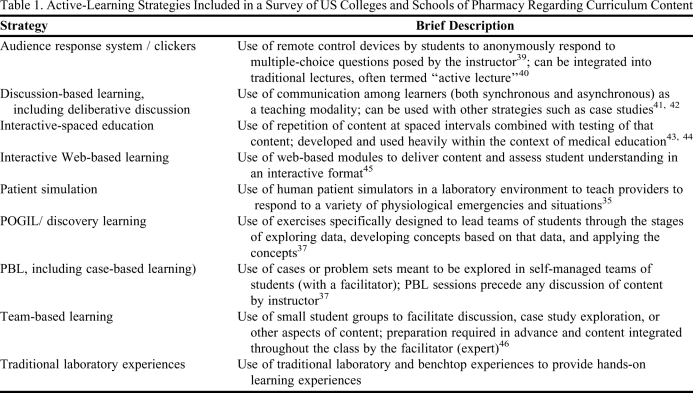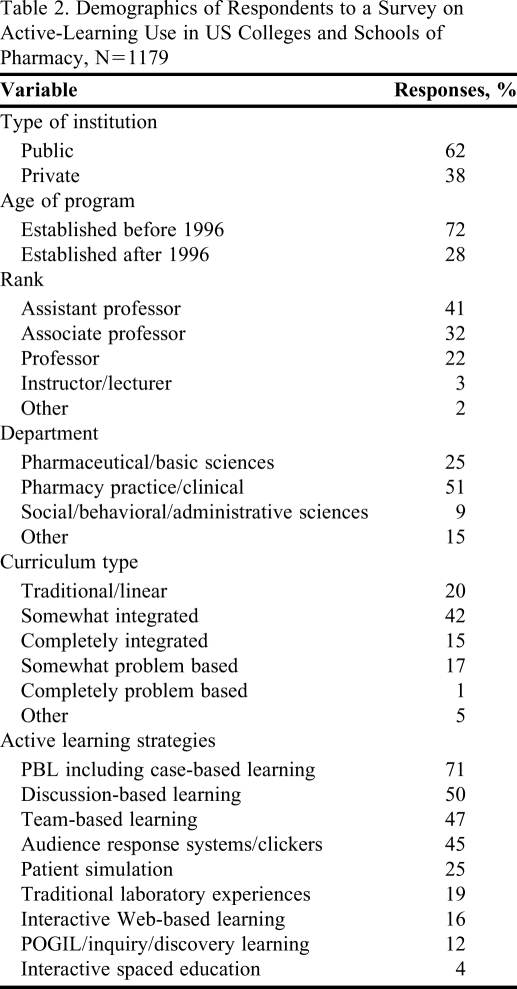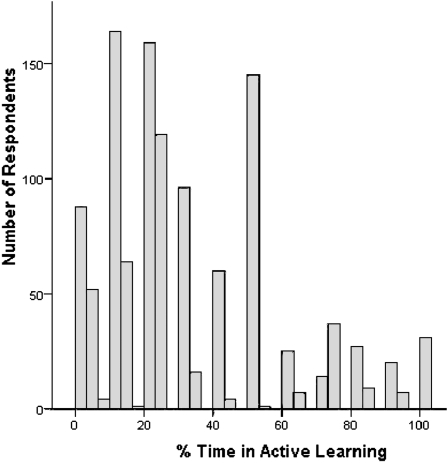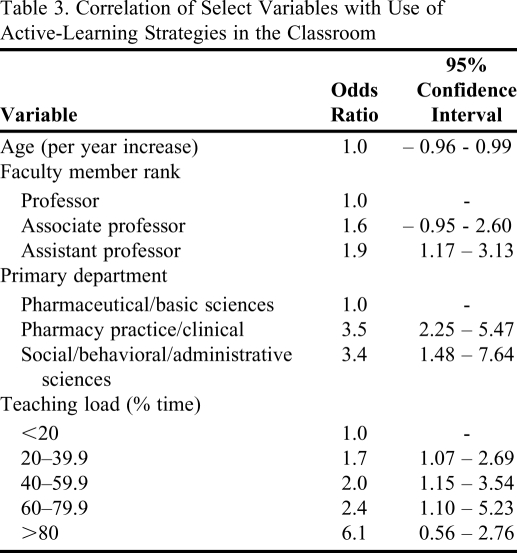Abstract
Objective
To document the type and extent of active-learning techniques used in US colleges and schools of pharmacy as well as factors associated with use of these techniques.
Methods
A survey instrument was developed to assess whether and to what extent active learning was used by faculty members of US colleges and schools of pharmacy. This survey instrument was distributed via the American Association of Colleges of Pharmacy (AACP) mailing list.
Results
Ninety-five percent (114) of all US colleges and schools of pharmacy were represented with at least 1 survey among the 1179 responses received. Eighty-seven percent of respondents used active-learning techniques in their classroom activities. The heavier the teaching workload the more active-learning strategies were used. Other factors correlated with higher use of active-learning strategies included younger faculty member age (inverse relationship), lower faculty member rank (inverse relationship), and departments that focused on practice, clinical and social, behavioral, and/or administrative sciences.
Conclusions
Active learning has been embraced by pharmacy educators and is used to some extent by the majority of US colleges and schools of pharmacy. Future research should focus on how active-learning methods can be used most effectively within pharmacy education, how it can gain even broader acceptance throughout the academy, and how the effect of active learning on programmatic outcomes can be better documented.
Keywords: pharmacy education, active learning, teaching, survey
INTRODUCTION
Pharmacy education is changing, and this change is being driven by a call for curricular innovation as well as an explosion of new pharmacy programs.1,2 The number of pharmacy programs increased by 45% between the years 1996 and 2008.2 As competition among colleges and schools increases, faculty members will be expected to accept the challenges that this new generation of pharmacy education presents. As noted by Oblinger, “the aging infrastructure and the lecture tradition of colleges and universities may not meet the expectations of students raised on the Internet and interactive games.”3
A 2009 review addressing future competencies in professional education highlights the need for learner-centered instruction and points to problem-based learning (PBL) and inquiry-based learning as means to accomplish this.4 PBL has a long history in medical education and has been used successfully in pharmacy education to teach diabetes, pharmacotherapy, pharmaceutics, medicinal chemistry, and pharmacoeconomics, as well as many other subjects.5-9 Students entering their advanced pharmacy practice experience (APPE) reported confidence in the material they had been taught using PBL, specifically medical information, basic science content regarding disease states, and patient-specific drug regimen evaluation.10 Compared with PBL, inquiry-based learning has had less of an impact to date on pharmacy education. Disease-focused discovery maps have been used to help students assimilate concepts across the curriculum.11 Inquiry-based learning has been used extensively in K-12 education and improves student attitudes about science.12 Other strategies for active learning used in pharmacy education include but are not limited to process-oriented guided inquiry learning (POGIL),13 case studies,14-17 computerized tutorials and modules,18-21 audience response systems,22,23 and team-based learning.24,25
The knowledge base in the field of healthcare continues to grow, but it is impossible to increase semester length or class time proportionally. Thus, moving forward, faculty members must recognize that active-learning strategies may be a valid way to address the increasing knowledge base by facilitating the training of pharmacy graduates who can find, process, analyze, and apply new information with their patients and their colleagues.26,27
Faculty members are being challenged by the academy to “adopt a philosophy of evidence-based education.”1 For the Bill Gatton College of Pharmacy, this project represents the first step toward this new philosophy, considering that the purpose of this project was to document the current national trend of engaging students through various processes, collectively termed active learning. In an attempt to make education culturally relevant to the current generation of learners, traditional approaches to classroom management may no longer suffice, and it is increasingly important to understand how others are successfully implementing curricular innovation.26,28,29 These data will help colleges and schools of pharmacy throughout the United States compare their use of active learning to a benchmarked standard specific to pharmacy education.
METHODS
A comprehensive literature search of medical and education databases evaluating the use of active-learning strategies in health-science education was conducted by a medical librarian and then sent to the authors for review. The authors reviewed each abstract for relevant articles and compiled a list of documented active-learning strategies. These strategies were then categorized and included in an anonymous survey designed to assess active-learning strategies used in US colleges and schools of pharmacy and the extent to which they are used. No comprehensive surveys of active learning in pharmacy or any other health science discipline were found by our literature search. Approval was obtained by the East Tennessee State University (ETSU) Institutional Review Board in November of 2009.
The online survey (available from authors on request) was evaluated by local faculty member volunteers for comprehension and functionality. It was then distributed by e-mail via the American Association of Colleges of Pharmacy (AACP) faculty member roster during the spring of 2010. A 2-week follow-up e-mail was sent to all potential respondents as a second request to participate in the project. The survey was closed after 4 weeks. Several active-learning strategies were given as options for survey respondents to indicate their use of various techniques. While this list was certainly not all-inclusive, it included some of the most prevalent strategies used in pharmacy and science education. Table 1 briefly summarizes the techniques given to the survey respondents as response options. No descriptions were included in the survey itself. Checkbox Survey (Checkbox Survey Solutions, Inc., Watertown, MA) was used to distribute and collect survey data. Responses were compiled and statistical analyses were completed using SPSS 16.0 (SPSS Inc., Chicago, IL). Chi-square tests were used to compare nonparametric data. Logistic regression analyses were used to detect correlations between respondent variables and to determine whether active-learning strategies were used. Results of logistic regression analyses were reported as odds ratios with 95% confidence intervals.
Table 1.
Active-Learning Strategies Included in a Survey of US Colleges and Schools of Pharmacy Regarding Curriculum Content
Abbreviations: POGIL = process-oriented guided inquiry learning; PBL = problem-based learning.
RESULTS
Invitations to participate in the survey were e-mailed to the 2,013 individuals in US and affiliated colleges and schools of pharmacy who held a faculty appointment, as determined by their AACP roster listing and 1,179 completed the survey instrument (59% response rate). Of the 120 colleges and schools of pharmacy recognized by AACP at the time of survey distribution, a response was received by at least 1 faculty member from each of 114 colleges and schools, yielding an institution response rate of 95% of all US colleges and schools of pharmacy.
Sixty-two percent of survey respondents taught at public institutions. Respondents were classified as members of public institutions for purposes of this survey if the college or school was located within a public university, regardless of whether public funds were provided at the college level. The majority of respondents (72%) were from institutions with pharmacy education programs established prior to 1996.
Most survey respondents (95%) identified themselves as full-time faculty members holding the rank of assistant professor, associate professor, or professor. Fifty-one percent of respondents were pharmacy practice or clinical faculty members, while 25% were basic sciences or pharmaceutical sciences faculty members. Seventy-nine percent of respondents described their curriculum as traditional/linear, somewhat integrated, or somewhat problem-based, while only 16% described their curriculum as completely integrated or completely problem-based. Overall, 87% of the 1,179 respondents reported the use of at least 1 active-learning strategy in their classroom activities, with PBL being most commonly reported (71%). Over 83% of respondents reported the use of 2 or more active-learning techniques. Survey results are listed in Table 2.
Table 2.
Demographics of Respondents to a Survey on Active-Learning Use in US Colleges and Schools of Pharmacy, N=1179
Abbreviations: PBL = problem-based learning; POGIL = process-oriented guided inquiry learning
The median percentages of workload devoted to classroom teaching and classroom time devoted to active learning were 30% and 25%, respectively. For participants who did not incorporate active-learning techniques, the 50th percentile of teaching time was approximately 20%, compared with approximately 30% for those who did engage their classes in active-learning strategies. This difference indicates that participants who used active learning tended to have higher teaching workloads compared with those who did not. The majority of respondents spent less than 40% of their time in the classroom engaged in active learning (Figure 1). A logistic regression analysis showed an overall significant correlation between use of active-learning techniques and an increase in teaching load (Table 3), when categorized in ranges of 20% extending from 0% to 100% (P = 0.035). However, when evaluating individual ranges, no significant difference was found between the group with a teaching load of >80% compared to the group with <20%.
Figure 1.
Percent of Time Engaged in Active-Learning Strategies
Table 3.
Correlation of Select Variables with Use of Active-Learning Strategies in the Classroom
Other factors significantly correlating with using active-learning strategies included faculty age, faculty rank, and department. As age increased, the likelihood of using active-learning strategies decreased by approximately 3% for each year increase in age (P = 0.001). The impact of age was similar to that of years in an academic job. Respondents who had fewer than 5 years’ teaching experience reported a 92% frequency of using active learning, compared with 85% of those teaching more than 25 years. Faculty rank usually correlates with age and years in service; likewise, in our study, 93% of assistant professors were using active-learning strategies vs. 91% of associate professors and 87% of full professors. Faculty members in departments of pharmacy practice (or any clinical faculty members) and faculty members in the social/behavioral/administrative sciences were more than 3 times more likely to use active-learning strategies compared with faculty members teaching in departments of pharmaceutical or basic sciences (P < 0.0001 and P = 0.004, respectively). This corresponds to 81% of basic science faculty members vs 94% of clinical faculty members using active learning.
Neither institution type (public vs. private) nor institution age (programs beginning prior to 1996 vs. those beginning after 1996) correlated significantly with the use of active learning. Institution age, however, did show a trend toward greater use of active learning at newer institutions (odds ratio – 1.7; [95% CI 0.999-2.919]).
DISCUSSION
As active-learning techniques have been encouraged in pharmacy education, an increase in the use of technology has often followed. Many of the techniques investigated in this survey either directly or indirectly increased the use of technology during the student's learning experience. Whether the use of technology directly influences the educational experience has not been definitively determined; however, several studies evaluating specific technologies have found positive results, primarily derived from user preferences.22,30-36 Ernst and colleagues also have demonstrated that additional active-learning exercises resulted in increased student examination scores compared with historical controls.32
The academy has embraced active learning, as demonstrated by the high rate of survey participants reporting use of active-learning techniques (87% of respondents). While the majority of respondents in the current study acknowledged using PBL, one limitation could be that this study included case-based learning as a descriptor in this group. Thus, faculty members who used cases in non-PBL teaching methods could have chosen PBL as a survey response. True PBL implies that students are not given any information prior to receiving their assignments (problems), which empowers them to direct their own learning with a facilitator who only guides them during the process. Future research could focus on differentiating PBL from other case-based strategies, such as discussion- and team-based learning in which students use cases only to reinforce and expound upon subjects in which they have already been instructed. Audience response systems (ARS) also seem to be a popular instructional tool that is easily embedded, even within traditional lectures.
In this survey, the likelihood of a faculty member using active-learning strategies decreased with increased faculty member age. This is likely related to the finding that assistant professors use more active-learning strategies compared with professors (93% versus 87%, respectively). It also may relate to the length of time the respondent had been in an academic job, as junior faculty members and 92% of faculty members teaching less than 5 years used some form of active learning.
Perhaps this finding warrants discussions regarding pedagogical philosophies at the level of the institution and the academy as a whole. Ideally, all educators would engage in pedagogical strategies that demonstrate superior student learning and satisfaction, and these improved outcomes would convince more senior educators to adopt these newer teaching philosophies. However, all educators realize the significant time and risk investment involved in implementing new teaching strategies, and with highly motivated students, such as those in a doctor of pharmacy (PharmD) program, faculty members often do not see the necessity of such an investment. Junior faculty members often have greater exposure to faculty development opportunities because of the requirements of promotion and/or tenure; thus, they may be instituting active-learning strategies at the course-development stage rather than altering established instructor-centered content. If the trend of higher percentages of newer faculty members adopting active learning continues, it could ultimately result in senior faculty members having increased exposure to innovative teaching techniques as well.
Another interesting finding was the increased use of active-learning techniques as classroom teaching workload increased. Faculty members with classroom teaching workloads above 20% used these strategies more often than those who spent less than 20% of their time teaching in the classroom. However, there was no significant difference in the use of active-learning strategies by faculty members who spent >80% of their time in the classroom, compared to the <20% group. Because of the small number of respondents with high teaching workloads (5.8%), these results should be interpreted cautiously. Overall, these data indicate that faculty members who spend more time teaching are more likely to use contemporary teaching strategies designed to engage students. Perhaps individuals who are passionate about classroom teaching are more likely to use evidence-based and/or newer teaching strategies. One possible confounder of this connection is the difficulty faculty members and administrators have in defining workload. Those who are more engaged in classroom assignments and thus more likely to use active-learning strategies may be those who invest more work time per credit hour.
The other significant finding was the decreased likelihood of basic and pharmaceutical sciences faculty members to use active-learning strategies (81% vs. 94%). While one hypothesis for this finding is that it is easier to engage in these strategies in clinical courses where cases and other clinical applications can be used for demonstration, several methods have been endorsed for the past 2 decades by the National Science Foundation (NSF). POGIL, PBL, and peer-led team learning (PLTL) all have been evaluated extensively in the undergraduate basic sciences, with POGIL and PLTL showing positive results, particularly in chemistry courses.13,37 While PBL has benefits, particularly in the clinical setting, students’ performance on science examinations after taking a PBL course has been observed to be lower.38
These data ultimately will be used for internal assessment at our college. They also might be valuable to other institutions as a benchmark of active-learning use in pharmacy education, as no other similar studies were found in a prospective review of the literature, but these data should not be interpreted as showing superior outcomes for active-learning strategies. These results should encourage the academy to further evaluate the evidence of their techniques and assess and publish outcomes-based data for evaluation.
CONCLUSION
We found that active learning has been embraced overwhelmingly in pharmacy education, based on a majority of colleges and schools using some active-learning techniques in their curricula. While some factors (ie, faculty member age and rank, department, and teaching workload) seemed to correlate with active-learning techniques being used, continued discussion and research should be devoted to this topic to elucidate how active-learning methods can be used most effectively in pharmacy education, how it can gain wider acceptance throughout the academy, and how its effect on programmatic outcomes can be documented.
ACKNOWLEDGEMENTS
The authors would like to thank the ETSU Research Development Committee Small Grants Program for funding this project (Project Title: “Use of Active Learning Strategies in US Pharmacy Education”) and Kefeng (Maylene) Qiu and Sylvester Renner, ETSU James H. Quillen College of Medicine Library, for assistance in identifying and retrieving reference material and providing support for Checkbox Survey, respectively.
REFERENCES
- 1.Blouin R, Riffee W, Robinson E, et al. AACP curricular change summit supplement: roles of innovation in education delivery. Am J Pharm Educ. 2009;73(8):Article 154. doi: 10.5688/aj7308154. [DOI] [PMC free article] [PubMed] [Google Scholar]
- 2.Knapp D, Knapp D. Attributes of colleges and schools of pharmacy in the United States. Am J Pharm Educ. 2009;73(5):Article 96. doi: 10.5688/aj730596. [DOI] [PMC free article] [PubMed] [Google Scholar]
- 3.Oblinger D Boomers. gen-Xers and millenials: understanding the new students. EDUCAUSE Rev. 2003;38(4):37–47. [Google Scholar]
- 4.Jungnickel P, Kelley K, Hammer D, Haines S, Marlowe K. Addressing competencies for the future in the professional classroom. Am J Pharm Educ. 2009;73(8):Article 156. doi: 10.5688/aj7308156. [DOI] [PMC free article] [PubMed] [Google Scholar]
- 5.Cisneros R, Salisbury-Glennon J, Anderson-Harper H. Status of problem-based learning research in pharmacy education: a call for future research. Am J Pharm Educ. 2002;66(1):19–26. [Google Scholar]
- 6.Fisher R. The potential for problem-based learnign in pharmacy education: a clinical therapeutics course in diabetes. Am J Pharm Educ. 1994;58(2):183–9. [Google Scholar]
- 7.Romero R, Eriksen S, Haworth I. Quantitative assessment of assisted problem-based learning in a pharmaceutics course. Am J Pharm Educ. 2010;74(4):Article 66. doi: 10.5688/aj740466. [DOI] [PMC free article] [PubMed] [Google Scholar]
- 8.Shin Y, Kauf T, Biddle A, Simpson K. Incorporating problem-based learning concepts into a lecture-based pharmacoeconomics course. Am J Pharm Educ. 1999;63(2):152–9. [Google Scholar]
- 9.Webster A, Riggs R. A quantitative assessment of a medicinal chemistry problem-based learning sequence. Am J Pharm Educ. 2006;70(4):Article 89. doi: 10.5688/aj700489. [DOI] [PMC free article] [PubMed] [Google Scholar]
- 10.Hogan S, Lundquist L. The impact of problem-based learning on students' perceptions of preparedness for advanced pharmacy practice experiences. Am J Pharm Educ. 2006;70(6):Article 127. doi: 10.5688/aj700482. [DOI] [PMC free article] [PubMed] [Google Scholar]
- 11.Chase P, Franson K, An A. Discovery maps: a student-centered approach to reinforcing the curriculum. Am J Pharm Educ. 2001;65(1):74–7. [Google Scholar]
- 12.Gibson HL, Chase C. Longitudinal impact of an inquiry-based science program on middle school students' attitudes toward science. Sci Educ. 2002;86(5):693–705. [Google Scholar]
- 13.Brown SA. process-oriented guided inquiry approach to teaching medicinal chemistry. Am J Pharm Educ. 2010;74(7):Article 121. doi: 10.5688/aj7407121. [DOI] [PMC free article] [PubMed] [Google Scholar]
- 14.Currie B, Chapman R, Christoff J, Sikorski L. Patient related case studies in medicinal chemistry. Am J Pharm Educ. 1994;58(4):446–50. [Google Scholar]
- 15.Reddy I. Implementation of a pharmaceutics course in a large class through active learning using quick-thinks and case-based learning. Am J Pharm Educ. 2000;64(4):348–55. [Google Scholar]
- 16.Sims P. Utilizing the peer group method with case studies to teach pharmacokinetics. Am J Pharm Educ. 1994;58(1):73–7. [Google Scholar]
- 17.Sims P. Utilizing the peer group method with case studies to teach pharmaceutics. Am J Pharm Educ. 1994;58(1):78–81. [Google Scholar]
- 18.Abate M, Meyer-Stout P, Stamatakis M, Gannett P, Nardi A. Development and evaluation of computerized problem-based learning cases emphasizing basic science concepts. Am J Pharm Educ. 2000;64(1):74–82. [Google Scholar]
- 19.Harrold M, Newton G. Development and evaluation of computer based tutorials in biochemistry and medicinal chemistry. Am J Pharm Educ. 1998;62(1):24–30. [Google Scholar]
- 20.Roche V, Aitken M, Zito S. Evaluation of computerized medicinal chemistry case study modules as tools to enhance student learning and clinical problem-solving skills. Am J Pharm Educ. 1999;63(3):289–95. [Google Scholar]
- 21.Wellman G, Larson R. Using web-based prescription simulations as an active learning tool in an integrated practice skills laboratory. Am J Pharm Educ. 2002;66(4):411–5. [Google Scholar]
- 22.Medina M, Medina P, Wanzer D, Wilson J, Er N, Britton M. Use of an audience response system (ARS) in a dual-campus classroom environment. Am J Pharm Educ. 2008;72(2):Article 38. doi: 10.5688/aj720238. [DOI] [PMC free article] [PubMed] [Google Scholar]
- 23.Slain D, Abate M, Hodges B, Stamatakis M, Wolak S. An interactive response system to promote active learning in the Doctor of Pharmacy curriculum. Am J Pharm Educ. 2004;68(5):Article 117. [Google Scholar]
- 24.Beatty S, Kelley K, Metzger A, Bellebaum K, McAuley J. Team-based learning in therapeutics workshop sessions. Am J Pharm Educ. 2009;73(6):Article 100. doi: 10.5688/aj7306100. [DOI] [PMC free article] [PubMed] [Google Scholar]
- 25.Letassy N, Fugate S, Medina M, Stroup J, Britton M. Using team-based learning in an endocrine module taught across two campuses. Am J Pharm Educ. 2008;72(5):Article 103. doi: 10.5688/aj7205103. [DOI] [PMC free article] [PubMed] [Google Scholar]
- 26.Howe N, Strauss W. New York, NY: Vintage Books; 2000. Millennials rising: the next great generation. [Google Scholar]
- 27.Wells B, Beck D, Draugalis J. Report of the 2007-2008 Argus Commission: what future awaits beyond pharmaceutical care? Am J Pharm Educ. 2008;72S(S):Article S8. [Google Scholar]
- 28.Prensky M. Digital natives, digital immigrants, part I. On the Horizon. 2001;9(5):1–6. [Google Scholar]
- 29.Prensky M. Digital natives, digital immigrants, part II. On the Horizon. 2001;9(6):1–6. [Google Scholar]
- 30.Cook D, Levinson A, Garside S, Dupras D, Erwin P, Montori V. Internet-based learning in the health professions: A meta-analysis. JAMA. 2008;300(10):1181–96. doi: 10.1001/jama.300.10.1181. [DOI] [PubMed] [Google Scholar]
- 31.Davis J, Crabb S, Rogers E, Zamora J, Khan K. Computer-based teaching is as good as face to face lecture-based teaching of evidence based medicine: A randomized controlled trial. Med Teach. 2008;30(3):302–7. doi: 10.1080/01421590701784349. [DOI] [PubMed] [Google Scholar]
- 32.Ernst H, Colthorpe K. Expanding voluntary active-learning opportunities. Am J Pharm Educ. 2008;72(2):Article 28. doi: 10.5688/aj720228. [DOI] [PMC free article] [PubMed] [Google Scholar]
- 33.Persky A. Multi-faceted approach to improve learning in pharmacokinetics. Am J Pharm Educ. 2008;72(2):Article 36. doi: 10.5688/aj720236. [DOI] [PMC free article] [PubMed] [Google Scholar]
- 34.Premkumar K, Coupal C. Rules of engagement - 12 tips for successful use of “clickers” in the classroom. Med Teach. 2008;30(2):146–9. doi: 10.1080/01421590801965111. [DOI] [PubMed] [Google Scholar]
- 35.Seybert A, Kobulinsky L, McKaveney T. Human patient simulation in a pharmacotherapy course. Am J Pharm Educ. 2008;72(2):Article 37. doi: 10.5688/aj720237. [DOI] [PMC free article] [PubMed] [Google Scholar]
- 36.Van Dijken P, Thevoz S, Jucker-Kupper P, Feihl F, Bonvin R, Waeber B. Evaluation of an online, case-based interactive approach to teaching pathophysiology. Med Teach. 2008;30(5):e131–6. doi: 10.1080/01421590801932210. [DOI] [PubMed] [Google Scholar]
- 37.Eberlein T, Kampmeier J, Minderhout V, et al. Pedagogies of engagement in science: a comparison of PBL, POGIL, and PLTL. Biochem Mol Bio Educ. 2008;36(4):262–73. doi: 10.1002/bmb.20204. [DOI] [PMC free article] [PubMed] [Google Scholar]
- 38.Albanese M, Mitchell S. Problem-based learning: a review of literature on its outcomes and implementation issues. Acad Med. 1993;68(8):52–81. doi: 10.1097/00001888-199301000-00012. [DOI] [PubMed] [Google Scholar]
- 39.Kay R, LeSage A. A strategic assessment of audience response systems used in higher education. Austr J Educ. Tech. 2009;25(2):235–49. [Google Scholar]
- 40.Banks D. Hershey, PA: Information Science Publishing; 2006. Audience response systems in higher education: applications and cases. [Google Scholar]
- 41.Brice L. Deliberative discourse enacted: task, text, and talk. Theory Res Soc Educ. 2002;30(1):66–87. [Google Scholar]
- 42.Gayford C. Science education and sutainability: a case-study in discussion-based learning. Res Sci Tech Educ. 1995;13(2):135–45. [Google Scholar]
- 43.Kerfoot B, DeWolf W, Masser B, Church P, Federman D. Spaced education improves the retention of clinical knowledge by medical students: randomized controlled trial. Med Educ. 2007;41(1):23–31. doi: 10.1111/j.1365-2929.2006.02644.x. [DOI] [PubMed] [Google Scholar]
- 44.Kerfoot B, Kearney M, Connelly D, Ritchey M. Interactive spaced education to assess and improve knowledge of clinical practice guidelines: a randomized controlled trial. Ann Surg. 2009;249(5):744–9. doi: 10.1097/SLA.0b013e31819f6db8. [DOI] [PubMed] [Google Scholar]
- 45.Mayer R. The promise of multimedia learning: using the same instructional method across different media. Learning Instruction. 2003;13(2):125–9. [Google Scholar]
- 46.Michaelsen L, Knight A, Fink L. Sterling, VA: Stylus Publishing; 2004. Team-based learning: a transformative use of small groups in college teaching. [Google Scholar]






